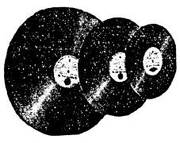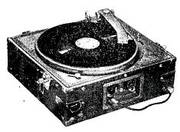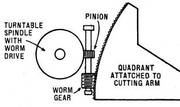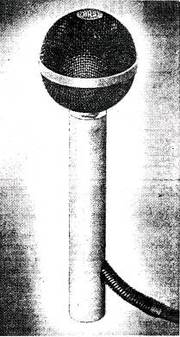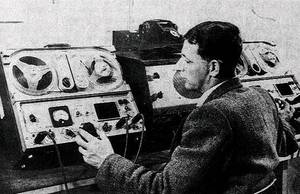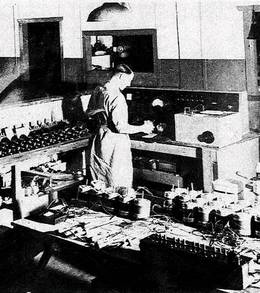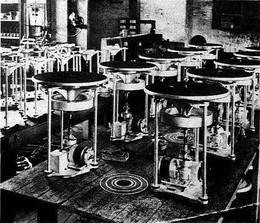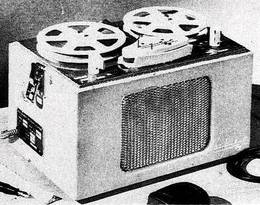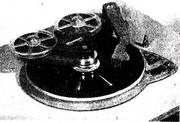Von einem Leser aus Australien haben wir sie bekommen
November 2020 - Die Freude ist besonders groß, daß wir nicht nur in Südamerika (Brasilien, Chile und Argentinien) Freunde gefunden haben, sondern auch in Australien. In Südamerika sprechen erstaunlich viele Bürger noch Deutsch und lesen diese deutschen Seiten. In Australien ist unsere Sprache nicht ganz so weit verbreitet, aber der google Translator macht einen guten Job. John Mackenzie hat uns einen 5 Seiten Artikel über den australischen "Tonbandmenschen" Max Byer geschickt - aus 1995.
.
When I Think Back...
MAX BYER:
Well made equipment for amateur and professional recordists
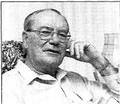
- Max Byer
Readers with a practical interest in sound recording, who can look back to the 1950's, should have no difficulty in recalling the name of Max Byer. The Melbourne based enthusiast / manufacturer produced distinctive and affordable disc and tape equipment for amateur recordists, along with an array of more pretentious models for professionals - including the ABC, commercial broadcasters and the Deptartment of Defence.
Wer diese Story geschrieben hatte .......
Appropriately, this story on Max Byer relies in large degree, on information collected by Harry Mauger. Featured himself in 'Think Back' for November 1994, Harry as you may recall is a retired recording engineer from Melbourne's Astor/Philips Group, and his contribution emphasises Max Byer's activities from a professional viewpoint.
Included were several photographs made available by Doug Richards, a former Byer employee who had the foresight to capture factory scenes with the idea they might one day be of historical value.
For my own part, the article also involved an exercise in recalling the past - but from the hobbyist level. Back in the 1950's, I was a professional technical writer by day, but with a strictly amateur spare-time interest in film and slide projection, stage presentation and music by night - in the context of suburban and rural church actvities.
Out of this latter activity came a hankering to make my own sound recordings - also on a strictly amateur basis. But as for other would-be recordists at the time, the problem was: how to go about it?
.
How to go about it?
Wartime wire recorders were available in limited numbers, but they were fiddly gadgets, and editing was difficult. Optical recording on film required professional back-up facilities. Magnetic tape looked promising, but was still in its infancy outside Germany.
That left direct recording on lacquer-coated discs as the obvious choice; blank discs were in good supply (Fig.l), as also were steel and sapphire cutting stylii.
Looking back, I remember seeing an advertisement for an overhead tracking and leadscrew mechanism to propel a recording head across a blank disc - and I was hooked!
I reckoned that I should be able to contrive a make-do recording head from a 78rpm magnetic pickup, and drive it from an ordinary amplifier. To set up a suitably husky turntable should be a breeze for my younger brother, trained as a machinist and with access to machine shop facilities.
.
How NOT to do it!
In due course, we had a 16-inch steel turntable, with spindle and bearing, balanced and true to within a 'whisker'. It was set up in a stout wooden frame, provided with rim drive using an available synchronous motor and topped off by my overhead lathe mechanism.
Fitted with an improvised recording head and a commercial cutting stylus, it was ostensibly ready to inscribe our first clean, unmodulated test groove.
Unfortunately, the aforesaid 'test' groove proved to be anything but clean - displaying a plainly visible 50Hz vibration pattern.
Apparently, the overhead traverse mechanism, bridging from the turntable spindle to the wooden frame, was reacting to residual vibration in the assembly and transferring it to the cutting head as a whole.
My brother and I had learned the hard way that the construction of a recording lathe called for a higher level of refinement than we had allowed for!
It was at about that time that I first sighted what was loosely identified as Max Byer's 'Junior' disc recorder. Mounted in a wooden box with lid and carrying handle (Fig.2) it looked rather like a portable record player of the era, to be hooked up to the family 'wireless'; a trifle larger, perhaps, and a little heavier, but much less cumbersome than our own ill-fated creation!
The first Byer 12" disc recorder
As I recall, that first Byer recorder had a 12-inch (30cm) diameter turntable, diecast, machined and topped with a synthetic rubber mat. Following 78 rpm practice, it was a single speed unit, rim driven from underneath by a compact, purpose-built phono type motor.
Lifting the lid revealed what looked like an old-style magnetic phono pickup, with needle chuck and thumbscrew to accommodate interchangeable play/cut stylii.
It was described as a combination pickup/cutter, but as a pickup it was in stark contrast to the new lightweight pickups being publicised at the time by firms like Goldring and Acos.
(There and then I/we decided that, if we ever did cut an acetate on the Byer, it would be replayed using the most compliant, lightweight pickup we could find, such as the Acos GP-20).
Worm & sector drive
The Byer 'Junior' had no overhead traverse mechanism. Instead, the pickup/cutter was locked to a spindle supported by a bearing through the assembly plate and carrying a sector vane underneath, as shown in Fig.3, reproduced from the May 1951 issue of this magazine, then known as Radio & Hobbies.
In cutting mode, the vane engaged a worm drive from the turntable spindle, which drove the sector and hence the attached cutter radially across the disc, producing the required spiral groove.
In the Byer recorder, the mechanism was normally set up to drive the stylus from the label towards the outer edge of the disc, leaving the 'swarf (lacquer 'string' removed by the cutting stylus) behind in the recorded area - hopefully clear of the stylus as it nudged its way progressively outwards.
Needless to say, my first reaction on encountering the disarmingly basic looking Byer recorder/player was to install a recording stylus and blank disc, and cut a plain groove. Despite the economy of design, the groove turned out to be visually 'clean' - evenly spaced and with no sign of mechanical vibration or 'rumble'. The designer/manufacturer had obviously known a thing or two!
.
Theatre background - who was Max Byer?
Well then, who was Max Byer? Here I turn to the information assembled for me by Harry Mauger.
According to Max's daughter Patricia Dryden (nee Byer), Maxwell Theodore Byer was born at Castlemaine, Victoria in 1914. As a young man, he trained as a theatre projectionist but later gravitated to technicalities, gaining considerable expertise in converting early 'silent' and sound-on-disc projectors to sound-on-film.
Presumably realising that this could only ever be an interim occupation, Max noted that there was a steady demand for acetate disc recording blanks - this at a time before the adoption of magnetic tape technology.
Accordingly, in the 1930's, he set up a small plant to manufacture acetate blanks at the rear of a factory at 8 Dorcas Street; South Melbourne. The enterprise was registered as Broadcast Recording Supplies (BRS).
When wartime (II world war) conditions created a shortage of blank discs, the role of BRS became critical. Used discs were recycled by stripping the acetate from the aluminium and, when aluminium itself became scarce, steel and even glass were used as a base.
.
Factory foreman
Prompted by Harry Meager, Jack Richardson, Byer's one-time factory foreman, jotted down a dozen-odd pages of handwritten notes which came as an eye-opener to a mere Sydneysider whose contact with BRS had mainly to do with hobby-level recording.
Recalling Byer's disc coating process, Jack explained that the discs were loaded in rows onto six rotating spindles, radiating spider-like from a central vertical column. Supported below them was a special tank containing the lacquer.
With the discs rotating, the tank was raised slowly just far enough to allow the lacquer to partially submerge both sides of one row of discs at a time, leaving un-coated an area around the spindle sufficient to accommodate the label.
The lacquer tank was then lowered, leaving the coated discs rotating on the 'spider' to drip and dry while the next row of discs was readied for their partial immersion.
Byer had two such six-armed spiders. Needless to say, it was essential that the process be carried out under dust-free conditions.
lacquer disc production
12-inch and 16-inch metal discs were normally sanded prior to coating, to ensure that the lacquer would adhere. Then they were heated under a half-ton pressure to ensure flatness.
Jack Richardson said that Max took up the production of disc recorders as much as anything to support the demand for his blank discs.
From the first basic portable model mentioned earlier, successive variants provided a two-speed facility with microgroove, another for either inside-out or outside-in recording, a special record-only head with harder suspension rubbers, and a supplementary purppse-built amplifier to provide for PA etc., as well as amateur recording.
The play/record heads were assembled in-house, as were moving coil pickups for use with recording lathes involving professional 12-inch and 16-inch turntables. For the latter, Byer Industries also produced their own overhead traverse mechanism.
.
Other products
Other items which came out of the factory included microphone stands, both single and boom types, ball type microphones and ribbon type mics for AWA - virtually RCA's well known 44BX under licence.
Additional to the above, in R&H for April 1951, I noted a full page advertisement for a B46-D 'Audio Cell' crystal microphone - non-directional, 40-8000Hz and moisture proof, obviously intended to 'look the part' for amateur use (Fig.4).
It is clear from Jack Richardson's letter that Byer Industries were also involved in making synchronous drive motors, initially for their own portable disc player/recorders and later for wire recorders manufactured by Pyrox. Max Byer, I gather, was something of a specialist in motors.
Adding to the picture, Jack mentions E-12" and E-16" professional turntables with 2-speed gate change and external drive; the T19, a 16" turntable with internal drive and cam speed change, originally 2-speed later 3-speed; the T33, a 16" turntable driven through a gearbox; and the T12, 2-speed involving taper on centre spindle.
At the height of this activity, someone developed a wow and flutter meter and, says Jack, "it was applied at Byers to just about anything that turned".
PMG inspectors used it to doublecheck turntables supplied for use by the ABC. "Later they installed a direct line from Byers to the PMG offices in Jolimont, so that inspectors could check turntables without having to travel to Jolimont. To provide the requisite test signal they used a 3.000 Hz test disc" - itself a potential, if marginal source of wow!
Und dann kam 1946 - the war was over
By 1946, Max Byer had taken over a larger section of the Dorcas Street premises, allowing him to cast in-house up to 16-inch transcription turntables for the broadcast industry. In 1947, further expansion saw occupation of the whole factory and incorporation as Byer Industries Pty Ltd.
When stereo sound appeared on the horizon, Max Byer was one of those who convinced Melbourne radio stations 3XY and 3UZ to cooperate in a public demonstration. Each broadcast one side of the stereo signal and the public were invited to listen to the result, with two radios in the same room tuned to the respective stations.
.
Byer too modest!
In effect, Jack Richardson's jottings presented what is now commonly called 'the big picture' - but 40 or more years too late!
Max Byer and staff had been so pre-occupied at the time in developing a succession of specialist products, that they omitted to publicise them to the degree they deserved.
At Radio & Hobbies we knew about their portable disc recorders and associated products, but I have no recollection of insistent press releases or advertisements to publicise the professional products mentioned by Jack Richardson.
To R&H readers, Byer Industries was seen as a modest Melbourne company involved mainly in portable disc recorders and associated what-nots!
For me, at a personal level, practical experience with amateur disc recording fell short of earlier expectations, anyway. Amateur performers proved more than ever prone to nerves and presentation lapses when they were being recorded.
And technically, there was always the risk of an overcut or an accident with the swarf, leading to the situation: "Your performance was okay but there's a fault in the disc. Sorry, but we'll have to do it all again."
Resultat der vielen Probleme mit den laquer discs
Faced with such situations, my enthusiasm for amateur disc recording waned markedly. Editor John Moyle fared rather better, as is evident from articles published in the early 1950's.
John's involvement with the technology peaked when he acquired a later version of the Byer recorder, able to produce a direct cut recording in the LP format: microgroove and 33rpm.
As a connoisseur of classical music, John saw it as an opportunity to record ABC concert broadcasts, particularly those carried by their 'experimental' FM outlet.
There was no problem with temperamental artists, and the performances had already been 'miked' and monitored to broadcast standards.
John generally managed to obtain blanks and stylii which would steer the swarf well clear of the uncut area. In any case, with the incoming signal under control, he was able to concentrate on the cut - camel-hair brush in hand, to nudge the swarf aside if the need arose.
.
Disc versus tape!
John Moyle was nothing if not enthusiastic about his home-made microgroove transcriptions, which he claimed compared well with the original broadcast and lost little by comparison with commercial pressings - this based on the immature standards of the day.
He was certainly not slow to report on his handiwork, which probably reinforced the public do-it-yourself concept of Byer Industries! (Ref: 'You Can Make Records At Home' by John Moyle, R&H December 1950 and January 1951.)
Als die ersten Magnetbandgeräte kamen
About the same time (about 1950 ??) magnetic tape and tape equipment made its tentative appearance on the local market, although it was the subject, initially, of much confusion about standards. There were four or more traverse speeds (30, 15, 7.5 and 3.75 inches/second), and the tape was variously spooled oxide-in or oxide-out.
The magnetic track(s) could occupy the full l/4" width of the tape or be 'halftrack' or 'quarter-track' and/or accommodate mono in various configurations - or conceivably, stereo.
The physical stiffness and flatness of tape also tended to vary with the brand, batch or age, which sparked endless arguments about tape and takeup methods - arguments about which we probably copped more than our fair share in the editorial office of R&H.
As it happened, I tended to be exposed predominantly to the Pyrox/AWA 'Magictape' recorder, which was utilitarian rather than trendy. But it convinced me that tape technology held the ultimate answer for both professionals and amateurs alike.
Max Byer's initial response to the appearance of tape was not to produce a self-contained tape recorder/player. Instead, with simplicity and economy in mind, he devised the unique BRS 'Magnofilm' tape adaptor, further reinforcing Byer's public image as a supplier to hobbyists.
.
Byer tape adaptor
Diecast and neatly finished (Fig.5), it was intended to be used in conjunction with his own disc cutter/player or any other phono turntable known to have adequate power and to be free from wow and flutter.
It was designed to straddle the turntable, with its rotatable shaft gripping the turntable spindle and two fixed legs resting on the motor board.
The turntable spindle would provide drive for the tape capstan, as well as powering the take-up spool via a slipping 'clutch' involving gravity and a felt washer.
The deck carried its own record/play head with a bias winding, for connection to an external preamplifier unit. Erasure required the use of a separate hand-held 50Hz bulk eraser.
Das Handling war nicht einfach
The adapter was less costly than a separate self-contained deck, and produced excellent recordings. But it required a fair amount of fiddling to set up, rewind, erase and load the tape.
John Moyle acknowledged its potential at the time but, to him, it provided another example of the 'messiness' that seemed to characterise the new medium. "Falls off the reel" was his oft repeated grouch about tape!
John didn't mind in the least being regarded as a 'disc' man. But, then again, he didn't live long enough to experience the 'tidiness' of the compact tape cassette, and its dramatic transformation from an inexpensive handyman system to a rival for top-quality stereo microgroove discs.
Here again, Jack Richardson's notes add depth to our personal recollections of that very early phase. Readying for the tape era and looking well beyond the humble tape adaptor, Byere engaged their own pattern maker, set up an in-house foundry for castings and prepared to do their own silk screening.
They put a lot of work into the production of tape heads in-house - sortie of which used .005" mumetal laminations, stacked and glued into blocks, heat treated and machined into shape. Special attention was given to head contour and positioning to optimise tape contact, and also to spooling motors controlled by DC to apply tension. At one stage, Byer pole pieces found a ready market in Canada, by reason of their superior performance.
First local recorder?
Aside from the tape adaptor, Byers also developed and released the first Australian continuous tape player. Jack still has painful memories of a tape loop containing the 'Happy Little Vegemites' advertising ditty, which was tested in the factory for weeks on end - driving everyone within earshot slowly around the bend!
It would appear that, having released his tape adaptor, Max Byer lost no time in developing self-contained tape recorders, such that Jack Richardson suggests that Max could reasonably be credited with producing the first-ever Australian-made unit.
The Byer 55, he says, was 'developed in a hurry' to keep things moving while they proceeded with the design of the more elaborate Byer 66.
Employing a single motor and mechanical function control, the 55 attracted favourable comment from the CSIRO for its simplicity of operation. Max Byer was so delighted that, uncharacteristically, he hired an aerial signwriter to write 'BYER 55' in the sky over Melbourne.
Seen as a 'domestic' recorder, the 55 was reasonably successful in its own right although admittedly - says Jack - it was "a bit of a nightmare" to service.
The Byer 66 and model 77
The Byer 66 was intended for the more demanding commercial market, and avoided the use of pressure pads and complex wrap-arounds for the tape. Well ahead of other portables, it was typically used for high-speed copying of speech and for background music at funeral services and other public gatherings.
In fact, Jack says that its performance was such that it was regarded as a neo-professional machine, "with very few shortcomings".
Basic amplifiers and auxiliary tuners, etc., for the Byer 66 were manufactured by Zephyr Products but were married to the tape system and double-checked at the Dorcas Street factory.
Following the 66 came the 77 Mk 1, Byer's first three-motor plus solenoid operated deck. Designed with the 1956 Olympic Games in view, at least 250 were supplied to the ABC, where they performed well.
.
Australian Magnecorder
What was possibly the supreme compliment to Max Byer came in R&H in June 1951, when it was announced that Byer Industries Pty Ltd had been granted exclusive manufacturing rights of the American 'Magnecorder' for the Sterling market.
The announcement continued: the Magnecorder ... is used more extensively in the United States than any other (professional) recorder ... and promises to prove extremely popular with Australian radio and electrical engineers ... It is understood that the first batch is already off the assembly line.
For the remainder of the Byer story, I am indebted mainly to Clive Sloss - who some may subsequently remember as a sales executive with Simon Gray Pty Ltd, the Melbourne hifi equipment distributor (Leak, Wharfedale, Ortofon, etc).
.
Clive Sloss war der Starverkäufer
Early in his career, Clive had gained experience in broadcasting as a technician with stations 3AK, 3XY and 3UZ. In the early 1960's, he applied for and gained a position with Byer Industries as Technical Sales Manager. His initial assignment was to promote the new Mark II versions of the Byer 66 and 77 reel-to-reel recorders.
I quote: "Accepting the position was a sheer delight. Max was a perfectionist and a great person; the equipment was well constructed and the technology was up to date at the time. Tripping around Australia soon became my vocation."
Clive could rightly claim that Byer Industries had a good reputation for their acetate discs, accessories including the RCA/AWA ribbon microphone, disc cutters and professional turntables (including those supplied to New Zealand).
There was the model 55 portable domestic tape recorder, model 66 rated as the best of the portables, the 77 and the Byer-built PTH Magnecorder - for many years the 'workhorse' of the broadcasting industry. And now, the Mark n 66 and 77.
Failing health - es ging auf die Gesundheit
According to Max Byer's daughter, her father encountered health problems in 1958 and 'retired' from the recording industry in 1958, although "he never really stopped creating and becoming engrossed in whatever he project he took up".
Clive Sloss says that for a period, a three-man management committee (including himself) looked after the business affairs of Byer Industries.
It became apparent to them that the Company was financially marginal, in that while Byer enjoyed some protection in the way of import duties, such was the competition that capital would always be a problem.
Ultimately, Byers was taken over by the Rola company of Richmond, who retained the factory at Dorcas Street but moved the Administration and Sales departments to their own head office.
Later, Rola itself was taken over by Plessey, who were then swallowed by Philips. In the process Byer Industries virtually disappeared as an entity.
Clive says that he lost personal contact with Max Byer, who apparently established a motel in Holbrook, NSW "which still bears the Byer name and logo". Max subsequently moved to Adelaide.
His daughter Patricia simply records that "after numerous business ventures, he eventually retired to the Mornington Peninsula in the early 1980's. He passed away in January 1985".
To round off the biography, I can do no better than quote from Clive Sloss' summary: "Byer Industries was a small but efficient organisation, led by a great man who was dedicated in the main to broadcasting and allied industries".
.
by Neville Williams - 20 ELECTRONICS Australia, August 1995
.

